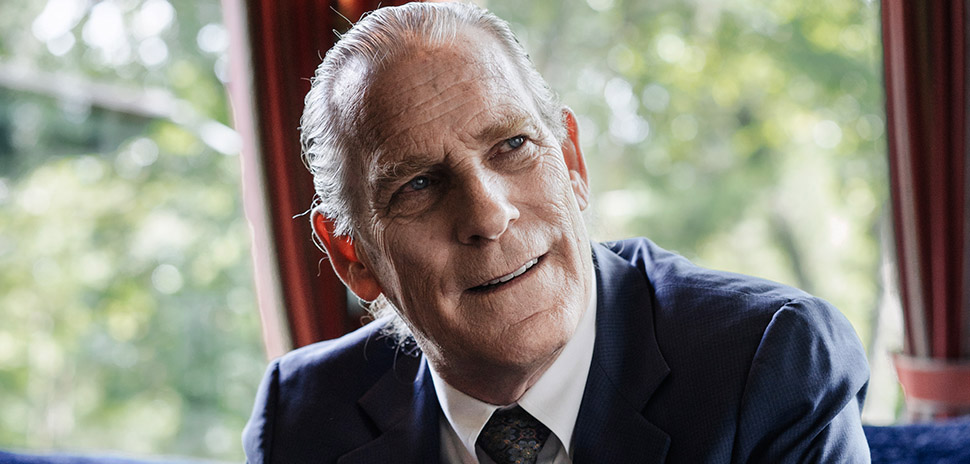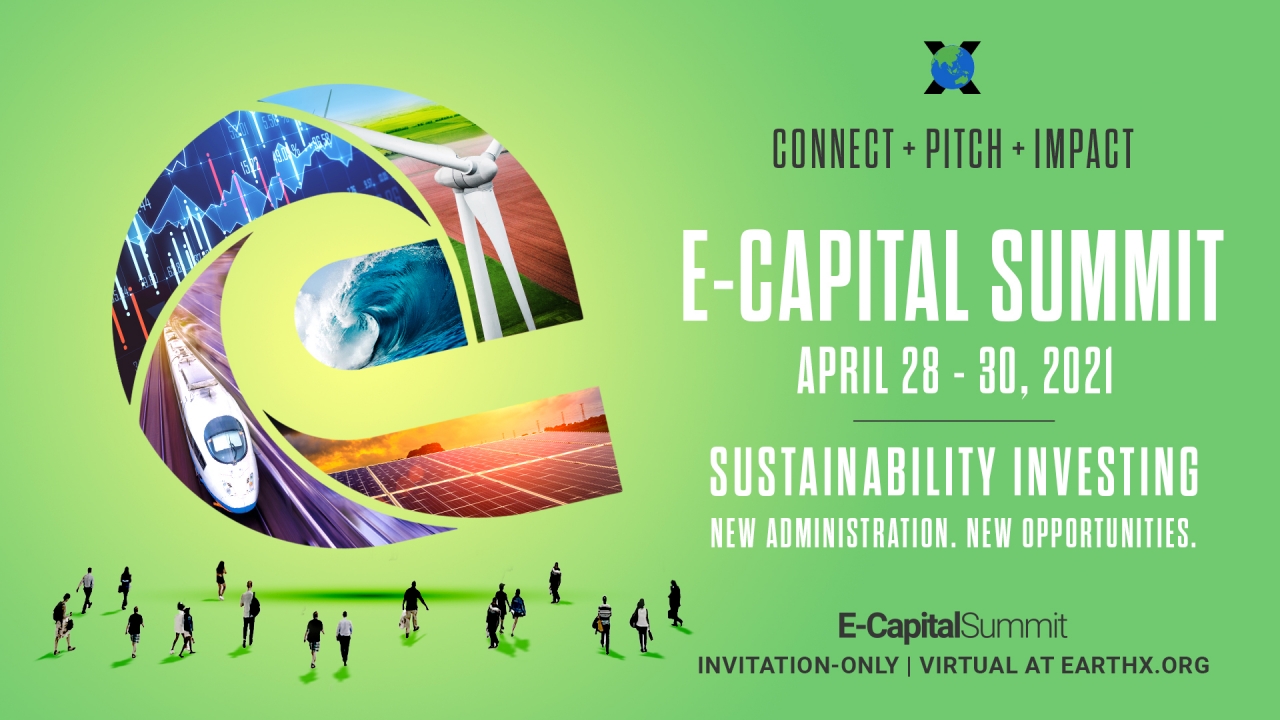
Trammell S. Crow, a Dallas-based businessman and father of four, is focusing his efforts on impact investing, and media that focuses on saving the planet through EarthX.
Smart investment firms know the writing is on the wall: Companies that make the environment count as part of their business model will outperform traditional businesses. It might take a couple of more years but putting sustainability practices first pays off. Recently, investors and bankers have learned that those same traditional businesses that have been profitable for decades may now be a liability as global awareness attunes to human, animal and planet rights.
Whistleblowers are waiting around any corner to derail steady stocks and bonds. How can your family office, bank, venture capital firm or bank steer clear of obstacles and invest in companies that put sustainability first and make planet and people count? Started in Dallas and now global, Trammell S. Crow founded EarthX and through it hosts an annual E-Capital Summit, tying investors and businesses together –- aligning them with the right frame of mind for future-forward business and environmental accountability.
Startups are invited too. Those that have attended the events over the last five years have gone on to raise about $500M in investment capital. It’s like Techcrunch for companies that care about the planet.
This year EarthX hosted its 5th summit. The event brought together policy makers from the White House, The Department of Energy, banks, family offices and traditional companies –– offering case studies and frameworks on how to build businesses that create a sustainability impact from the bottom up –– or from the top down.
“Our vision is to demonstrate to industry leaders from the investment, business, and deal making systems that sustainability and profitability are not mutually exclusive but actually go hand-in-hand.” says Vikram Agrawal, Director of EarthXCapital, the impact investment arm of EarthX.

Vikram Agrawal, EarthX
Some of the topics cover finance innovation in sustainability infrastructure. Few traditional businesses may not realize that the entire solar energy business, for instance, is built on feed-in tariffs and building solar infrastructure for your company can be a new stream of income. Are you managing a family fund and want to create climate-forward investments for your portfolio that are risk averse? Are you running an NGO, green energy business or leading government and city policies on investment in infrastructure? We’ve tapped into one of America’s leading minds on impact investing. Take 5 minutes and dive into what Vikram Agrawal says on how green financing can spur rapid environmental turnaround.
Vikram’s EarthX Capital is run by EarthX, America’s largest environmental expo, conference, film festival, and virtual TV channel, and is a member of IUCN, International Union for Conservation of Nature. EarthX was founded in 2011 as Earth Day Dallas by environmentalist and businessman Trammell S. Crow.

Samuel Rigu, EarthX Climate Tech Prize 2021 winner and CEO and founder of Safi Organics. Safi has developed a process to manufacture fertiliser using a thermochemical treatment of crop residues such as rice husks; Wang’uru, Kenya.
Green Prophet to Vikram Agrawal: Tell us a little about your background?
Vikram: I am a mission-driven, operationally-focused investment and management professional with an ethos that everyone deserves an opportunity to be successful, however they define success. I have nearly 15 years of experience across several industry sectors in the United States and the emerging markets (Latin America & the Caribbean and emerging Europe, Middle East, & Africa).
I started my career in investment banking and international finance focused on the emerging markets but, over the past seven years, I have been focused on US private equity, having worked with both companies in need of a strategic or operational turnaround as well as those in full-on growth mode.
While developing several investment theses related to sustainability and resiliency, I met Trammell S. Crow, a well-respected Texan environmentalist, businessman, and philanthropist. Trammell founded EarthX, an international environmental nonprofit organization based in Dallas, Texas that is dedicated to educating and inspiring people and organizations to take action towards a more sustainable future.
Trammell and I decided to partner together where I would have a dual mandate. I am launching a private investment firm focused on sustainability & resilience-related companies. In addition, I am helping lead the EarthxCapital team which has a mission to develop an investment, business, innovation, and deal-making ecosystem focused on leading and catalyzing impact and action.
My passion for sustainability, conservation, and resiliency started when I was young. It fully blossomed nearly twenty years ago when I had the opportunity to work on sustainability initiatives in rural India. I witnessed how solar energy installations, water conservation, and better agricultural practices could drastically improve people’s lives and provide them with critical resources that I took for granted growing up here in the United States.
Since then, I have realized that sustainability is not only important for the earth, for environmental justice, and for tackling broader social challenges –– including creating millions of much-needed jobs. I realize that sustainability is critical for business and investments by driving profitability, enhancing value, and driving risk-adjusted returns.
Why do we need such an event, and why now?
In April 2021, we hosted the 5th annual invitation-only E-Capital Summit. EarthxCapital’s signature event of the year seeks to convene, inspire, and catalyze action from hundreds of global investment firms, early to late-stage innovators, established global companies, industry leaders, policymakers, incubators & accelerators, dealmakers, and researchers. Our objective is to have substantial, positive impacts on investments, businesses, people and our planet.

In a highly polarized society that is dominated by misinformation, we take great pride in convening a diverse group of individuals and organizations representing a diverse group of perspectives in the middle of America: Dallas, Texas. We actively seek all perspectives and civil (and well-informed) discourse from all parties, regardless of the industry or profession you represent or whether you are a Democrat or Republican, climate change believer or denier, pure capitalist or philanthropist. We urgently need to have more inclusive debates with opposing views where we learn to collaborate and value each other’s diverse perspectives to better develop solutions.
What we all need to realize is that a majority of us share similar values and goals and that it will take a holistic solution from the investment, business, policy, research, civic, and non-profit communities partnering together to solve short-term and long-term challenges. At the end of the day, we all want clean water & air, a resilient economy and supply chains, jobs for millions of Americans, power & energy, and a better future for generations to come.
However, being sustainable is trending and sexy today. Don’t get me wrong: this is great but it could also lead to “greenwashing” and have negative implications if investors lose capital, like they did a decade ago in the last cleantech bubble, especially if the public markets’ “ESG play” falters.
Many traditional investors and businesses are wary of this but will continue to do what they can to “check the box” if large investors and consumers demand this. Therefore, to truly have sustainable sustainability, it’s critical to show how sustainability and profitability are not mutually exclusive, but in fact go hand-in-hand. It’s our mission to show how sustainability can improve a company’s profitability, improve resiliency, and create a greater Strategic Value Proposition thereby enhancing value and increasing risk-adjusted returns.
How is the investment climate different under Biden?
Even prior to President Biden being sworn in as President, there was significant interest in sustainability investing. The International Finance Corporation, a World Bank Group, estimates that in 2020, ~$2.1 trillion AUM of a total of $10 trillion AUM was focused on impact investing in private markets.
However, President Biden is providing guardrails for sustainability investing through his fiscal policy and regulatory agenda. For example, billions of dollars in the infrastructure bill will support many cleantech and sustainability-related initiatives including EV infrastructure, energy/power grid resilience, and water infrastructure. Unfortunately, investors will be wary of such changes (especially if they are done via Executive Order or without bipartisan support), as they could be easily undone by a new Administration.
It remains unclear what the Biden Administration’s impact will be on sustainability investing but I’d bet most people would say that it will have a very positive short-term and long-term effect.
How has Covid changed anything in Impact investing?
First off, please allow me to offer my condolences and thoughts with the millions of people around the world who were impacted by COVID-19 and the global pandemic, which continues to ravage on. Unfortunately, millions of people around the world lost their lives and an even greater number of people will be impacted for years to come due to various economic, social, and health – physical and mental – challenges. We will need to develop innovative solutions to overcome those challenges.
To answer your question, impact investing can mean different things depending on who you ask. For the purpose of our discussion today, I’ll be focusing on environmental sustainability related issues given the focus of EarthX; however, that doesn’t diminish the importance of many other critical topics and challenges that are being addressed by a variety of impact investors including Diversity, Equity, and Inclusion; inequality and justice; health and wellness; access to education, and many more.
The pandemic highlighted the importance of resilience but also magnified the global inequalities and challenges faced by many daily, many of which are addressed by the UN’s Sustainable Development Goals (SDGs). From a COVID-19 prevention and treatment perspective, millions of people do not have access to clean drinking water – or even water to wash your hands – nor do they have access to proper nutrition (giving your body and its immune system to fight a virus).
These are only a few examples of the many investment opportunities that comprise the $2.5 trillion annual financing gap needed to achieve the SDGs. Many investors have responded by focusing their investment and philanthropic endeavors in underserved communities and look to be creative in finding opportunities to address these challenges. Given Covid-19, there may be greater emphasis, which is very much needed, on topics and investment theses related to environmental justice and health and wellness.
Can you give us three trends to look out for in the coming year?
Tension between greenwashing and defining what sustainability means
It seems like every week we hear an announcement from a major financial institution or corporate leader on their massive investment or pledge towards a new ESG or sustainability-focused strategy.
As an environmentalist, I’m excited to see the news every week but am wary if such announcements will convince traditional investors and businesses to execute long-lasting strategies. For example, I see this challenge with carbon offsets. First, I’d argue that carbon or GHG footprint reductions by operational or business plan improvements are in fact better than carbon offsets from unrelated sources.
Footprint reductions are permanent solutions and can hopefully be good for business profitability, which also leaves more offsets for other essential businesses unable to change operationally or a stronger foundation to rebuild the environment. Second, as Bloomberg has reported before, there aren’t enough trees (or land) in the world to support these continued statements. Therefore, to preserve credibility we must address true measures to address sustainability, but what does “sustainability” actually mean?
I always joke that if you ask five different people what sustainability means, you get ten different answers. However, as major institutional investors and public/private asset managers continue to employ and pledge trillions dollars of assets towards “sustainability” investment strategies, it will be important to define what constitutes sustainability.
As a pragmatist, and as a newly adopted Texan, I am excited to highlight how traditional energy companies are making oil and gas operations more sustainable. Oil and gas is critical to our economy, employs millions of Americans, and is a valuable resource for multiple end-products. While still holding the industry accountable for its actions, we should bring them to the table and celebrate their efforts, not shun them.
However, I’m sure many of your readers and many of my friends are raising their eyebrows as I put sustainability and oil and gas in the same sentence. So I ask, is making oil and gas a more environmentally-friendly sustainability strategy? I think so but others may disagree.
Developing measurable metrics
In addition, it will be important to identify standardized specific and quantifiable metrics, both of which have inhibited acceptance among traditional investors. The Biden Administration has already started to broach this issue and I’d expect some critical discussion in the coming months.
For example, the Wall Street Journal has done great coverage on this subject especially looking at companies deemed to be ESG top-performers and how various rating agencies ranked these companies differently on their sustainability scorecard due to differing metrics. Investors and businesses prefer standardization and certainty. It’s hard to plan if the goal line keeps moving.
Resilience
Resilience is the new buzz word and will be one of the most important topics for discussion across industry verticals globally. As with sustainability, resilience will become a dominant discussion topic especially as individuals and businesses grapple with increasing disruptions related to everyday activities.
A recent conversation with a major US city’s Chief Resilience Officer reminded me how resilience encompasses a broad range of issues. However, my current focus is on environmental and severe adverse weather resilience. COVID-19 and the recent February winter storms highlighted how ill-prepared our mission-critical industries are to shocks to the system.
As we begin to recover from COVID-19, I expect this to be a topic at more dining room tables, in more boardrooms, and in the halls of Washington, DC.
What kinds of businesses are most at risk if they don’t start to think “impact”?
Not to sound cliché, but every single business will be at risk. However, it will not be a one-size fits all strategy. For example, climate change and severe adverse weather events will have an impact on critical infrastructure assets, global supply chains, and the built environment. Not only will key industries like power, water, and food/ag be impacted (thereby challenging millions of Americans and billions of humans around the world), severe adverse weathers will affect all industries.
Mother Nature doesn’t know the difference between Blue and Red states. According to the NOAA, over the past 40 years, the United States has had more than 250 severe adverse weather events that have caused more than a billion dollars of damage (inflation adjusted) totaling more than $1.7 trillion… important to note that this doesn’t even include the hundreds of other “smaller” severe adverse weather events that happen each year across the country. This has a direct financial impact on insurance companies and businesses seeking access to insurance and capital.
From a finance perspective, it feels like every week you hear of another international financial institution that proclaims their intention to limit their exposure to fossil fuels, thereby increasing the cost of capital for companies with high exposure to such resources. With increased costs of capital, the energy industry will face reduced returns and capital expenditures thereby increasing the cost of traditional energy.
This, interestingly enough, could make alternative fuels and sustainable forms of energy more attractive from a cost competitiveness basis thereby giving them sufficient time to mature and increasing long-term competitiveness as compared (think of the drop in cost per unit of energy from solar and wind technology given increased adoption over the past two decades).
Can you give us an example of innovation in sustainability investing? I brought up the idea of solar and feed-in tariffs, can you give another?
I’ve learned that one of the greatest challenges for sustainability investing is the lack of patient capital for truly innovative enterprises. Unlike other innovations or industries, many clean technology and sustainability-related solutions take time to develop, commercialize, and eventually drive a return.
In addition, unfortunately, political gridlock has also inhibited private and public capital inflows for solving less sexy sustainability-related issues like infrastructure. Therefore, as I have learned of different forms of “innovation” in sustainability investing I’ve been impressed by many organizations that are looking to solve those problems. However, two firms – both past E-Capital panelists – with innovative financing models have come to mind:
Prime Coalition is a 501(c)(3) public charity that partners with mission-aligned investors to support extraordinary companies that combat climate change, have a high likelihood of achieving commercial success, and would otherwise have a difficult time raising adequate financial support to scale. Prime has leveraged catalytic capital, including grants and program-related investments, to drive much needed investment in innovative companies from patient and risk-tolerant capital providers. Most importantly, they don’t look to sacrifice returns while supporting industry game-changers.
Quantified Ventures is leading outcomes-based financing solutions across the country, solutions very much needed to solve our country’s environmental and aging infrastructure crisis. The firm is credited with structuring the first ever Environmental Impact Bond in the United States for DC Water, which helped them solve several challenges. DC Water was able to implement green infrastructure through an approach that shared performance risk with investors by linking their returns to the project’s success. I expect an increase of these forms of investment/financial structures throughout the country.
If you had unlimited capital, where would you put it first? 3 ideas — you have access to a magic genie
I think this is a better question for folks who are much smarter and more experienced than me (and with a lot more capital)! However, based on my experience, the following examples could be some of the greatest opportunities (in addition to the themes I’ve mentioned previously like resilience which I’ve been thinking about for several years now):
Sustainable Solutions for traditional industry
Although we like to focus on easily marketable and identifiable sustainability initiatives (like replacing plastic straws), true fundamental changes to consumer or business behavior will be needed to move the needle.
For example, investing in corporate sustainability and resilience is great for business and investments by improving profitability, strengthening business resilience, creating a greater Strategic Value Proposition, and enhancing value for all stakeholders thereby increasing risk-adjusted returns.
Inflation adjusted, the US economy has grown ~2% over the past 20 years and ~3% since World War II, however no investor or business would deem that as a high ROI for an individual investment. Therefore, if top-line growth is focused to be so low, then significant measures need to be taken to improve gross margins and operating margins, thereby improving net profit margins.
These initiatives (like the Circular Economy) can be good for business but also great for people and the environment, especially when they concern efficient use of materials and critical resources like energy and water. McKinsey & Company has done several studies that support how sustainability and profitability can go hand-in-hand. If I had unlimited capital I’d be targeting these areas as the opportunities are endless and can help sway traditional businesses and investors to implement simple measures.
Supply chains for leading innovators
Everyone likes to highlight the business and financial success of industry-leading sustainability innovators like Tesla, Chargepoint, AppHarvest, NextEra Energy, and point to them as the best sustainability-focused investment opportunities. That could be true, but I think you also need to focus on the incredibly diverse set of companies that are needed to support these large enterprises and their supply chains.
If we expect growth in any of the sustainability-focused end markets, capital (and patience) will be needed for those businesses that are supporting sustainability innovation and completely new industries.
EV Infrastructure and energy storage
Regarding an industry-specific opportunity, I believe that Mobility, in particular EVs, is one of the hottest sectors for the public and private investment markets. Now, before I start greenwashing you, let’s be reminded that EV cars only represent ~2% of the US car market today. However, this is a significant increase from the past decade where some reports put market share at less than 0.2%!
Earlier this year, California announced that all new car sales will need to be electric by 2035. As published in the journal Nature Climate Change, University of Toronto researchers found that 90% of US cars would need to be electric by 2050 to meet stated climate goals.
However, according to a Deloitte consumer auto study, the greatest concern for 54% of Americans was the perceived shorter driving range and lack of EV charging infrastructure. If investment professionals, policy makers and the auto industry hope to capitalize on the tremendous environmental, business, and investment opportunity, this issue must be addressed. We need greater EV infrastructure to support the increase in EV unless you think Green Hydrogen is a more realistic proposition.
::EarthX



